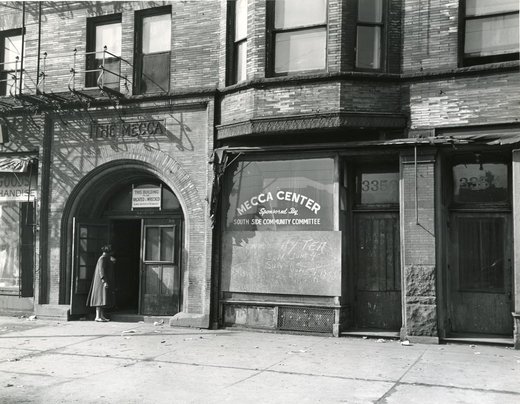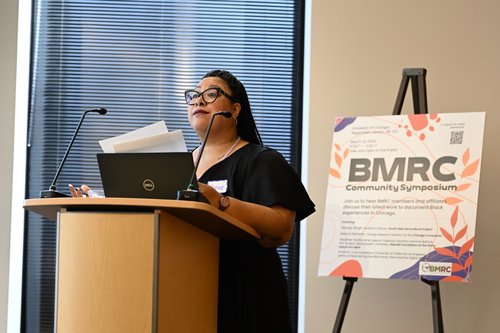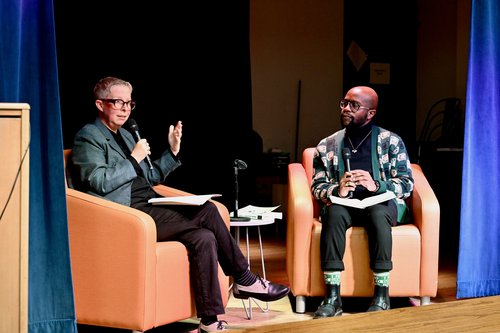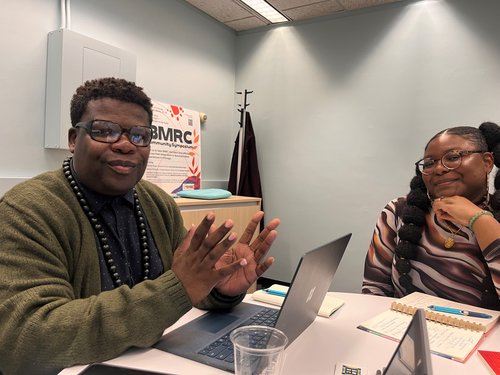So Glad to be Here: BMRC’s 2024 Work in Retrospective
January 28, 2025

“African American things had little chance to last. This is a painful lesson learned by family historians and museum curators. How could people who were property acquire and pass down property?”
- Tiya Miles, All that She Carried: The Journey of Ashley’s Sack, a Black Family Keepsake.
Image credit: Mecca Flats, Chicago, Illinois, ca. 1951
Held by Illinois Tech (IIT) Library
I had just finished rereading Tiya Miles book, All that She Carried a few weeks ago, when I returned to the BMRC offices at the start of the new year to find that we had received a large brown envelope in the mail. It was addressed to the BMRC from a woman on the far south side of Chicago. Inside the envelope were plastic sheets containing pages that had literally been taken from a photo album and a printed letter. Each page from the photo album held four black and white photos that were still adhered tightly to the paper. Two loose photos tucked into the plastic sheet were taken at celebrated Black photo studios that once operated in the city. The letter explained that the photos belonged to an in-law of the sender, a woman who had passed away in 1971, thirty years after migrating to Chicago from Mississippi. The letter writer said that she said sent them to the BMRC because she did not want them to be destroyed and that she “pray that you can keep them in your collection.”
Let us be clear – the BMRC offices do not collect archival materials - but our expanding consortium of 26 libraries, archives and museums do. (This year, we had the honor of welcoming three new members to the BMRC - Chicago Covenants, Movin’ Legacy and the National Public Housing Museum). We have already been in contact with the appropriate academic library archive member with a complementary collection, who will acquire the photos. Nevertheless, I was struck by the deep desire to save these photos which document the history of a specific family while speaking to a larger shared experience. What an honor that they would be sent to the BMRC which continues, on multiple fronts to do the work of locate, valorize, and increase access to and use of archival materials of Black experiences in Chicago.
The day after receiving those photos, a man in the grocery store came up to say how much he had enjoyed recent BMRC events, He mentioned specifically, the talk by Germaine Barnes we held at the Blackstone Branch of the Chicago Public Library in partnership with the Art Institute of Chicago. So, while the past year has not been without its challenges, there are so many validations that this work is important and necessary. [ See image of Germane Barnes speaking at Blackstone Library]

Taking helm of the BMRC in January 2024 has been a homecoming for me and I think often of my great-grandparents and grandparents who, as part of the Great Migration, escaped to Chicago from Alabama and Mississippi. I imagine that they would be tickled to see the work I am able to do because of their sacrifices.
During the last year we have worked to recharge the BMRC and its place in the archives and cultural heritage landscape of Chicago and beyond. In March of 2024, we hosted a Community Symposium keynoted by Dr. Tonia Sutherland (UCLA) which included presentations by BMRC members from the Southside Home Movie Project, Rebuild Foundation, and one of our newest members, Chicago Covenants. We also hosted an online lecture by Dr. Mary Francis Phillips on Wellness and the Black Panther Party for Women’s History Month. [ See image of Tonia Sutherland speaking at Community Forum]

The past year has been an opportunity to remind some and introduce others to the work of the BMRC. I have tried, with the encouragement of the BMRC Board of Directors to let more people know about the work of the BMRC. The BMRC’s logo was redesigned by Seyun Om and the website redesign (still in implementation phase) was carried out by Hannah Hong. There is a great story behind the connection of the new logo to African American quilting traditions and the earlier phase of the Civil Rights Movement that we wrote about on our website here.
We teamed up with Truth and Documentary and our BMRC community to make a short video explaining our work. Take a moment to watch it, if you have not already had a chance.
At the beginning of the summer, we received the big news that we received a grant from the Mellon Foundation as a part of the FOCAS project. It provides us with $590,000 to support community archives though paid internships for MLIS students from marginalized backgrounds.
Over the summer we also continued to champion research and exploration in archives and in possible careers in archives through our Summer Research Fellowships for academics, local historians, and artists and Archie Motley Archival Internships for undergraduate and MA students. [ See image of Archie Motley intern Chanelle D. in summer 2024]

The summer was also a time to do on the ground outreach. In August, the BMRC set up a table at the University of Chicago Library Open House. It was a great opportunity to speak with members of the community about our work, their family histories and family archival collections.
Also that month, we went big at the Society of American Archivists (SAA) Annual Meeting that took place here in Chicago, offering three scholarships for African American and other African diaspora MA students in Library and Archives to attend the annual meeting and sponsoring First-timers/Newcomers coffee break attended by a large number of attendees on the first day of the gathering.
In the Fall, I was able to personally participate in the orientation of the Black Metropolis Graduate Assistantships on the campus of Northwestern University. It is a great initiative in which we collaborate with Northwestern to open archival and cultural heritage horizons to Humanities PhD students while they work in one of our BMRC member institutions.
The BMRC Annual Meeting, which had not been held in person for several years was generously hosted by our member, the Vivian Harsh Collection at Woodson branch of the Chicago Public Library. We had more than 100 participants online and in person, and an amazing opportunity to hear from Laura Helton, author of Scattered and Fugitive Things: How Black Collectors Created Archives and Remade History and learn from the rich discussion she had with Steven Booth, Manager of the Johnson Publishing Company Archives about the theory and practice of Black archives. The archivists and cultural heritage professionals in the audience appreciated the conversation and called it a rare opportunity to discuss the social realities of archival processing and its effects. [ See image of Laura and Steve at BMRC 2024 Annual Meeting]

In November, we were able to welcome the BMRC Black Visual Arts Researcher, Rashieda Witter and the inaugural BMRC Poet in the Archives, Chicago Poet Laureate, avery young, on the SAME DAY! The Terra Foundation for American Art and the Dorothy Donnelley Foundation have generously supported the work of the Black Visual Arts Researcher position, and we look forward to the incredible work Rashieda and avery will do in using art to bring forth the stories of people in the archives. [ See image of avery and Rashieda]

We also hosted a Fall Speaker Series where Summer Research Fellows presented their work and a lecture by Dr. Johnnie Hamilton Mason on the League of Women for Community Service Archives and the Black Women’s Club Movement.
While we do not care for collections at BMRC offices, we do help people with archival collections find appropriate homes they can trust when they are ready to donate. We also receive a consistent flow of archival reference questions, mostly generated by people searching our Archives Portal, that we either answer or refer to the appropriate person at our members’ archives.
As should be clear to most, Black people (and a lot of other people) are still in the process of becoming free in terms of civil rights. The BMRC’s work is part of the process. We work to find, bring to light, and celebrate Black presence in archives and therefore in history and in everyday life. Presence is something that can be felt and intuited, but not necessarily seen and acknowledged.
Over and over again, during this past year, as we have done public outreach, we have heard, “I’m so glad the BMRC is here” from diverse members of the public, but especially from people of Color. We too, are glad to be here. We accept to be, along with you, custodians of Black memories, and fully present.
I thank the BMRC staff, Board of Directors and supporters who facilitate this work.
Please consider a donation to the BMRC if you can.
In Peace,
Sumayya Ahmed
Executive Director
Black Metropolis Research Consortium